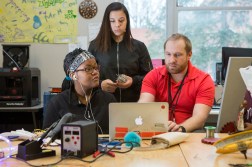North Dakota arms teachers with cybersecurity resources statewide through national partnership

EduTech, the education arm of North Dakota’s statewide technology agency, became the first state-level partner of a federal cybersecurity education provider late last month.
K-12 teachers across the state will be offered computer science-based curriculum and professional development training from the National Integrated Cyber Education Research Center, or NICERC. The Louisiana-based organization, funded through a DHS grant, has worked with more than 12,000 teachers and has worked in all 50 states, but this is its first long-term, state-level agreement.
That will make it the first sustainable plan to provide STEM materials throughout a state, said NICERC Director Kevin Nolten.
“We go out and provide provides curriculum to teachers, provide training to teachers, but because of the nature of our grant, we’re only able, because of our funding, to seed activities across the country,” Nolten said. “It’s a natural fit to work with [EduTech] to take what we have developed and provide boots on the ground, implementation and sustainable activities within the state.”
The agreement marks the next step in North Dakota’s K-20W initiative, the vehicle for Gov. Doug Burgum’s goal to see every student in every North Dakota school — “kindergarten through PhD” — receive a cybersecurity education. It’s a collaborative effort between 40 different agencies and organizations in the state to align its educational, workforce, military and IT sectors to create a comprehensive approach to cybersecurity education, but the partnership with NICERC cements a reliable curriculum-building partner to ensure that the state’s cybersecurity education will actually prepare students for the future of work.
“The state of North Dakota sees an opportunity moving forward. We believe that technology is changing every industry across the board — every job, every industry, every government. The reality is that we have to prepare our students for the 21st century workforce,” Shawn Riley, North Dakota’s chief information officer, told EdScoop.
A key goal, Riley said is to make a program that can be replicated by other states.
“We know we can’t solve the workforce issue all by our little lonesome,” Riley said. “It’ll take the entire country, but there’s no reason we can’t lead the way.”
Riley is the primary stakeholder for the K-20W initiative. As a neutral party who oversees the state IT office, Riley said he’s been able to bring every group to the table, from university systems to K-12 districts and organizations to get past the “how” in improving cybersecurity education.
Because NICERC will now offer its teacher-training and curriculum resources on a state level as opposed to a classroom level, Nolten says it’s an opportunity to create a long-term STEM plan for the state. The organization has given North Dakota $100,000 to provide in-classroom technology, and began certifying teachers under its curriculum this summer that included courses in cybersecurity and programming. The state reports it has 225 educators currently accessing resources, with plans to train more.
NICERC’s content, Nolten said, is built to scale in difficulty between grades. The goal is to teach how computer science and cybersecurity can apply in the real world, rather than merely in the abstract.
“As an example, we must teach series and parallel circuits in the middle school classroom,” Nolten said. “Instead of drawing a label on the whiteboard or chalkboard that has a battery, wires and circle light bulbs, let’s give the students a bag of wires, a bag of light bulbs, a bag of switches, a bag of batteries, and lets have them build it. That’s project-based learning, but what we do is take it a step further and give it a context that’s relevant to today.”
That additional context is key, he said, to prepare students for a 21st century workforce. Teachers using a NICERC curriculum might begin a lesson on electricity by explaining a hypothetical scenario of the U.S. power-grid going down due to a cyberattack, and allow students to build a flashlight out of circuits to “investigate.” That in-class application of STEM, Nolten said, will prepare students for a future that revolves around cyberspace.




